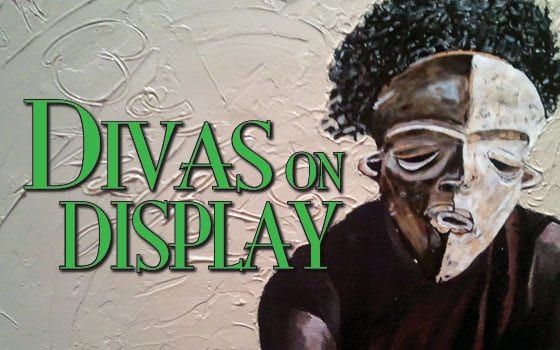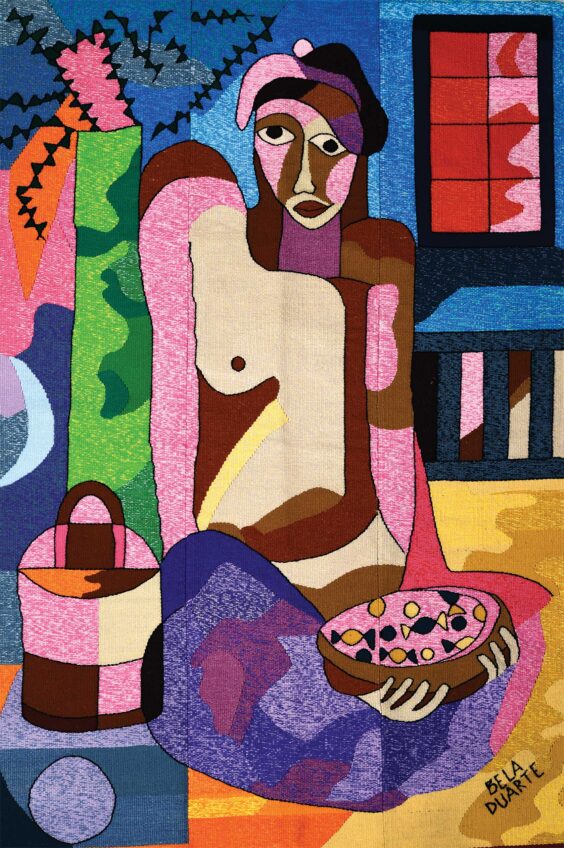

Author: Margaret VendryesFolk singer Tracy Chapman wears a Pende mask in “Pende Tracy” for the reinterpretation of her sepia toned album cover for “Crossroads.”

Author: Jacquinn WilliamsFolk singer Tracy Chapman wears a Pende mask in “Pende Tracy” for the reinterpretation of her sepia toned album cover for “Crossroads.”
Exhibit examines beauty and power behind the mask
The Africana Center at Tufts University is sponsoring the “African Divas Art” exhibition by Jamaican American artist, professor and curator Margaret Rose Vendryes from March 4-31.
A reception that included a tour and talk with the artist kicked off the exhibition last Friday.
“African Divas Art” examines the identities and new levels of power afforded to female artists of African descent and the impact of their packaging for public consumption. This exhibit asks us to think about our culture’s standards of beauty; how these standards apply across races; and by the inclusion of ancestral masks, makes explicit the dissection of black female bodies and “the short self life” of talented women of African descent in popular culture.
Most of the 20 works on display are reinterpretations of album covers of famous African American musicians such as Tammi Terrell, Mariah Carey, Tracy Chapman and Aretha Franklin.
Vendryes takes the images from the covers and replaces the faces of the women with African masks. During the talk, Vendryes explained that she used Photoshop to move the masks on an off of celebrities faces to find the right fit. Though the method may seem impersonal, somehow the masks chosen for each works perfectly.
Tina Turner’s wears the Yaka mask. According to San Jose State University’s African Art and Culture, the mask is used during the circumcision initiation of young males. The face portion is usually made out of polychrome and painted different colors representing the trials and tribulations of the initiates.
Beautiful and talented, Turner has gifted the world with hits like “What’s Love Got to Do with It” and “Proud Mary.” Turner has triumphed over the abuse she suffered at the hands of former husband Ike Turner. With the public battle behind her, it’s befitting that she dons the larger-than-life Yaka. Yaka or yakala means “males,” “the strong ones,” thus Bayaka, “the strong people.”
Etched into the oil paintings of each starlet are words from songs that seemingly exemplify the artist’s personality. The words “Born to Fight” from Tracy Chapman’s “Crossroads” album are almost face level on the painting. Her 1988 album “Tracy Chapman” was a multi platinum success; her second album “Crossroads” was far less successful. It was moody and dark and after her third album “Matters of the Heart” was met with mixed reviews, Chapman was thrust into cult status.
Never one to give up, she made a comeback with her fourth album “New Beginning.” Vendryes captured all of Chapman’s spirit, the good and the challenging when she painted the singer with a half black and half white Pende mask.
“Tracy’s music strikes a melancholy chord with me and she was one of those images where I actually allowed the music and voice to guide the look of the painting,” Vendryes explained. “The album image is sepia and since it is an iconic image for her career, and a full-bodied one that fit my criteria, I decided to paint it monochrome, which was hard because I missed having the color to do some of the emotional work.
“[It] turned out that the body in that image didn’t need the color to be explosive,” Vendryes continued. “Again, it was her music and the look on her face that made the Pende “sickness” mask a dead ringer. It is danced in time of need and mourning and Tracy sings of those things in a very powerful way.”
Grace Jones, the strikingly gorgeous and sexy model/singer is painted with an intricately adorned Igbo mask. Her lithe body has one leg stretched behind her with her face looking forward.
“The most fascinating masks for me are those which represent dances where the men make a great effort to move like the female spirit they are inhabiting,” Vendryes said. “Of the group I have in the show, the Igbo Spirit Maiden mask that I chose for Grace Jones is particularly dynamic for a woman like Grace who has a reputation for presenting herself in a very sexual and androgynous manner. The Igbo groups also tend to make very elaborate mask as well and I enjoy the work involved in painting those intricate forms.”
Professor Vendryes received her bachelor’s degree in fine arts from Amherst College, a master’s degree in art history from Tulane University, and a second master’s degree and Ph.D. in art history from Princeton University.
She taught at Princeton University and Amherst College before entering the faculty at York College and the Graduate Center of City University of New York where, as associate professor of art history, she received tenure in 2006. Among several honors, Vendryes held a 2003 American Association of University Women Fellowship and is a former Scholar-in-Residence at the Schomburg Center for Research in Black Culture.
Her “African Divas Art” exhibition will be on display until the end of the month.






